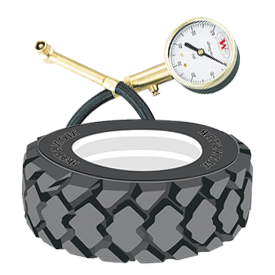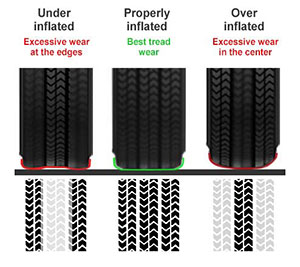Tyre Care
DO's :-
Maintain correct inflation pressure as recommended by the vehicle manufacturer or tyre companies.
Get air pressure of your tyres checked at least once in a fortnight.
Always check the air pressure when the tyres are cold (i.e. within 2killometers of drive). It is normal for tyres to heat up and air pressure to go up as you drive.

Increase inflation pressure by 30 kPa (5 psi) over the car maker’s recommendation, when going on a long journey or sustained high speed.
Replace defective valve cores and always use valve caps.
Visually inspect your tyres for uneven tread wear regularly.
Have your wheel alignment and balancing checked periodically particularly whenever you have indications such as ‘pulling’ or ‘vibrations’.
Respond immediately to changes in vehicle handling or mechanical faults specially while driving on highways/expressways.
Use only recommended rim size, tyre size, ply rating, load index and speed symbol.
Ensure nuts are in place and properly tightened.
Ensure that the tyre/tube is fitted correctly on rim.
Always use the correct size of tube for a given tyre size.
Check your tyres regularly for cuts and damages.
DON'Ts :-
It is desirable not to use radial and bias tyres on the same vehicle. If you have to, ensure that you use radials on the rare axle.
Overinflate or under inflate tyres.

Reduce air pressure build up caused during tyre running.
Use damaged, badly repaired, retreaded or worn tyres on expressways.
Use damaged, dented or cracked rims.
Drive over potholes or against kerbs.
Brake, stop or turn suddenly.
Use tube for bias tyres in radial tyres or vice-versa.
Use old or repaired tubes for new tyres.
TIPS TO AVOID TYRE BURSTS :-
One of the possible reasons of accidents on highways and expressways is tyre burst. These are known to occur in many cases as a result of neglect by a motorist. For example low or excess air pressure, worn out tyre patterns, damaged, badly repaired or poorly retreated tyres.
Some people under inflate tyres to improve the ride comfort. This compromises the vehicle safety and can result in burst in a high speeds due to excessive flexing and resultant heat generation. Excessive under inflation could also lead to weakening of the tyre carcass.
Tyre bursts can also occur because of neglected or improperly repaired cuts.
TRED WEAR INDICATORS (TWI) - All Indian car tyres are provided with tread wear indicators for timely removal for safety reasons.
A simple visual check for obvious signs of uneven wear can go a long way to improve the life of your tyres and vehicle suspension.